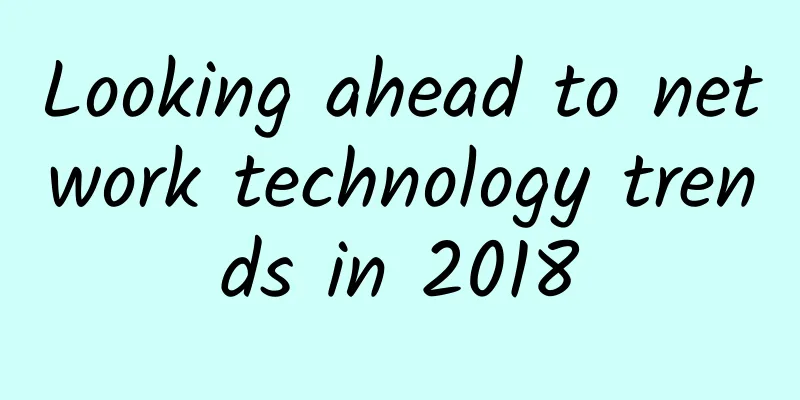Looking ahead to network technology trends in 2018

|
If 2017 was considered the year of major disruptive technologies, what else will happen in 2018? 2018 will be remembered as the year IT professionals need to adapt to a huge shift in the way enterprise IT operates. In the past few years, virtualization, cloud computing, the Internet of Things, and advanced data center technologies have all lived up to expectations. So, let’s take a look at four technologies that will become technology trends in 2018 and have the potential to change your business.
1. Cloud hosting for everything Infrastructure components are much easier to manage in the cloud than in an on-premises data center. Connecting to a corporate office via VPN and then launching a remote desktop application to access infrastructure management tools will soon be a thing of the past. Management of all infrastructure services (including servers, applications, databases, security tools, network hardware) can be accessed through an HTML5 portal accessible from anywhere in the world. This will not only simplify the practice of troubleshooting after hours, but will also usher in a new era of remote IT workers who are unaware of physical boundaries. 2. Serverless computing Among the technology trends in 2018, the adoption of serverless computing by enterprises will increase significantly. Thanks to great advances in technology from cloud computing service providers, including Amazon Web Services, Google Cloud, and Microsoft Azure, serverless computing is gradually eliminating the need for operating systems when deploying applications and services in the cloud. Serverless computing looks like a container-based technology that will be the next major evolution in enterprise computing. Serverless computing has made huge progress in the past few months. As a result, many people have begun to claim that they will no longer use traditional server operating systems. 3. AI-integrated applications Today’s applications will not only run faster and be easier to use, but they will also become smarter. Many vendors seek to integrate artificial intelligence (AI) into applications that are already in use today through developers. From an infrastructure perspective, adding artificial intelligence to the 2018 technology trends means more computing power, increased bandwidth requirements, and lower latency between applications and end users. In fact, AI is increasing the real-time data requirements of some critical business applications to the point where they are as important as traditional voice and video communications. Therefore, enterprises need to be prepared to adjust their service quality strategies and prioritize AI-integrated applications. 4. Unified enterprise applications Finally, advances in API tools and development platforms will lead organizations to unify their entire suite of enterprise applications in a meaningful way. APIs open the door for two or more previously separate applications to be combined to share information between applications. Instead of relying on users to extract relevant data from multiple applications to make business decisions, API access, automation, and artificial intelligence will be used. Developers will create these unified enterprise applications to save time and streamline business functions. At first glance, it may seem that AI-integrated applications have little impact on the IT infrastructure side of the IT business. But a closer look reveals that combining data from two or more applications requires quite a bit from a backend perspective. This is especially true when an enterprise is working in a large, distributed hybrid or multi-cloud environment. If this is the case, the enterprise may need to deal with issues such as data silos, network latency, and other network connectivity and optimization tasks. |
<<: Probably the most comprehensive inventory of well-known 404 pages at home and abroad
>>: 7 New Year's Resolutions for the Internet of Things
Recommend
RAKsmart flash sale server starts from $30/month, cluster server starts from $142/month, in the US/Japan/Korea/Hong Kong data centers
Earlier this month, I shared information about RA...
[cyberMonday] DediPath: VPS starts at $10 per year, dedicated server starts at $108/three months, 1Gbps unlimited traffic, multiple data centers in Los Angeles and other places
DediPath has launched a Cyber Monday promotion....
Tencent Cloud Lighthouse Care, help you get up to 200 yuan in coupons
Tencent Cloud recently launched a lightweight wor...
What is the difference between a cell and a sector? What about carrier frequency and carrier wave?
Cell, sector, carrier and carrier frequency are a...
5G vs. WiFi 6: Tips for choosing the best wireless network option
There has been much to prove about 5G’s theoretic...
CloudCone Black Friday pre-sale released, Los Angeles MC data center KVM annual payment starts from $14.2
Black Friday is still a long way off, but some bu...
Cisco HyperFlex, the world's most complete hyper-convergence architecture
[51CTO.com original article] Hyper-convergence is...
my country's industrial Internet platform construction faces four major bottlenecks
The Guiding Opinions of the State Council on Deep...
Why some cities are reluctant to adopt 5G
Most of the discussion about 5G has centered arou...
Anti-unified prescriptions ensure the security of prescription data and promote the healthy development of the medical industry
Hospitals can be said to be places closely relate...
Forecast of the layout of the three major operators in 2018
2017 is coming to an end. In this year, the total...
The US 5G goal is "cold"! No one expected that the "ban" would slap itself in the face
Last year, the iPhone 12 was launched. The most o...
OneDNS: Building the first line of defense for enterprises with SaaS-based DNS security services
With the increase in remote office and branch off...
How much do you know about the TCP three-way handshake principle?
I recently encountered a problem where the client...
Good news for 5G: the rate is no higher than 4G, and you don’t need to change your phone number when you change your phone
Large bandwidth, large connections, low latency a...









